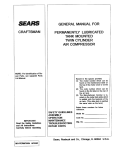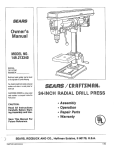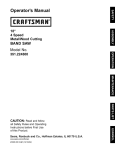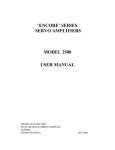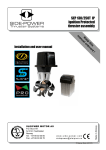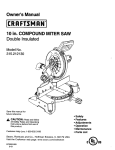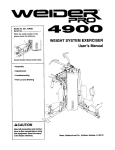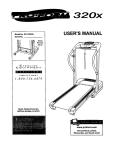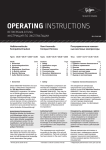Download Craftsman 226.165290 Operator`s manual
Transcript
Operator's Manual CRRFTSHRNo Permanently Lubricated Tank Mounted AIR COMPRESSOR Model No. 226.165290 CAUTION: Read and follow all Safety Rules and Operating Instructions before First Use of this Product. Sears, Roebuck and Co., Hoffman Estates, IL 60171_L' _,&, 17939.00 Draft (01/07/02) • • • • Safety Rules Operation Maintenance Parts List Warranty ....................................... not equipped) of your compressor. Follow the equipment manufacturers recommendation and never exceed the maximum allowable pressure rating of attachments. Never use compressor to inflate small low-pressure objects such as children's toys, footballs, basketballs, etc. 2 Safety Rules .................................... 2 Glossary ..................................... Installation.................................... 2-3 3-4 Always wear ANSI Z87.1 approved safety glasses with side shields when using the compressor. Operation .................................... Maintenance .................................. 4-6 6-7 Never point any nozzle or sprayer toward any part of the body or at other people or animals. 7 Always turn the compressor off and bleed pressure from the air hose and tank before attempting maintenance, attaching tools or accessories. Storage ....................................... Troubleshooting ................................ Parts Illustration and List ....................... 8-9 10-11 Never operate the compressor outdoors when it is raining or in wet conditions. Never operate compressor with protective covers removed or damaged. FULL ONE YEAR WARRANTY AIR COMPRESSOR ON CRAFTSMAN Any electrical wiring or repairs required on this product should be performed by authorized service center personnel in accordance with national and local electrical codes. If this Craftsman air compressor fails due to a defect in material or workmanship within one full year from the date of purchase, return it to the nearest Sears Service Center in the United States, and Sears will repair it free of charge. If this air compressor is used for commercial purposes, this warranty applies for only 90 days from the date of purchase. • • This warranty gives you specific legal rights and you may also have other rightswhich vary from state to state. Sears, Roebuck and Co., Dept. 817WA, Hoffman Estates, IL 60179 • WARNING: For your own safety read all of the instructions and precautions before operating tool. CAUTION: Always follow proper operating procedures as defined in this manual even it you are familiar with use of this or similar tools. Remember that being careless for even a fraction of a second can result in severe personal injury. • Always operate the compressor in a well ventilated area free of combustible materials, gasoline or solvent vapors, • If sprayingflammable materials, locate compressor at least 20 feet away from spray area. An additional length of hose may be required. Store flammable materials in a secure location away from compressor. • Never place objects against or on top of compressor. Operate compressor in an open area at least 12 inches away from any wall or obstruction that would restrict the flow of fresh air to the ventilation openings. • Operate compressor is a clean, dry, well ventilated area. Do not operate unit indoors or in any confined area. • Always remain in attendance with the product when it is operating. • Drain tank daily or after each use. If tank develops a leak, replace it immediately with a new tank or replace the entire compressor. Never drill into, weld or make any modifications to the tank or its attachments. • The tank is designed to withstand specific operating pressures. Never make adjustments or parts substitutionsto alter the factory set operating pressures. • For essential control of air pressure, you must install a pressure regulator and pressure gauge to the air outlet (if • • Make certain that the electrical circuit to which the compressor is connected provides proper electrical grounding, correct voltage and adequate fuse protection. Air obtained directly from the compressor should never be used to supply air for human consumption. In order to use air produced by this compressor for breathing, suitable filters and in-line safety equipment must be properly installed. In-line filters and safety equipment used in conjunction with the compressor must be capable of treating air to all applicable local and federal codes prior to human consumption. Work in an area with good cress-ventilation. Read and follow the safety instructions provided on the label or safety data sheets for the material you are spraying. Use a NIOSH/MSHA approved respirator designed for use with your specific application. Never touch any exposed metal parts on compressor during or immediately after operation. Compressor will remain hot for several minutes after operation. Do not reach around protective shrouds or attempt maintenance until unit has been allowed to cool. Always operate compressor in a stable secure position to prevent accidental movement of the unit. Never operate compressor on a roof or other elevated position. Use additional air hose to reach high locations. Become familiar with these terms before operating the unit. CFM: Cubic feet per minute. SCFM: Standard cubic feet per minute; a unit of measure of air delivery. PSIG: Pounds per square inch gauge; a unit of measure of pressure. Code Certification: Products that bear one or more of the following marks: UL, CUL, ETL, CETL, have been evaluated by OSHA certified independent safety laboratories and meet the applicable Underwriters Laboratories Standards for Safety. Cut-In Pressure; While the motor is off, air tank pressure drops as you continue to use your accessory. When the tank pressure drops to a certain low level the motor will restart automatically. The low pressure at which the motor automatically restarts is ca[led "cut-in" pressure. 2 Cut-Out Pressure: When an air compressor is turned on and begins to run, air pressure in the air tank begins to build, it builds to a certain high pressure before the motor automatically shuts off - protecting your air tank from pressure higher than its capacity. The high pressure at which the motor shuts off is called "cut-out" pressure. fit in outlet, have proper outlet installed by a qualified electrician. • Inspect tool cords periodically, and if damaged, have repaired by an authorized service facility. • Green (or green and yellow) conductor in cord is the grounding wire. If repair or replacement of the electric cord or plug is necessary, do not connect the green (or green and yellow) wire to a live terminal. Where a 2-prong wall receptacle is encountered, it must be replaced with a properly grounded 3-prong receptacle installed in accordance with National Electric Code and local codes and ordinances. Branch Circuit: Circuit carrying electricity from electrical panel to outlet. • LOCATION OF THE AIR COMPRESSOR WARNING: Any receptacle replacement should be performed by a qualified electrician. Locate the air compressor in a clean, dry and well ventilated area. The air compressor should be located at least 12" away from the wall or other obstructions that will interfere with the flow of air. The air compressor pump and shroud are designed to allow for proper cooling.The ventilation openings on the compressor are necessary to maintain proper operating temperature. Do not place rags or other containers on or near these openings. A temporary 3-prong to 2-prong grounding adapter (See Figure 2) is available for connecting plugs to a two pole outlet if it is properly grounded. Grounding Lug \ Adapter__S. -- Make Sure This =_=,==_1_Is Connected _=_',,=,,,, To A Known POWER SOURCE The motor is designed for operation on the voltage and frequency specified. Normal loads will be handled safely on voltages not more than 10% above or below specified voltage. Running the unit on voltages which are not within range may cause overheating and motor burn-out. Heavy loads require that voltage at motor terminals be no less than the voltage specified on nameplate. 3-Pron__ 2-Prong Receptacle Figure 2 - 2-Prong Receptacle with Adapter • Air compressor requires a 115 volt, 60 Hz power source, GROUNDING INSTRUCTIONS • WARNING: Improper connection of equipment grounding conductor can result in the riskof electrical shock. Equipment should be grounded while in use to protect operator from electrical shock, • • • Check with a qualified electrician if you do not understand grounding instructions or if you are in doubt as to whether the tool is properly grounded. This tool is equipped with an approved 3-conductor cord rated up to 240V and a 3-prong grounding type plug rated at 115V (See Figure 1) for your protection against shock hazards. • Grounding Preng • • --" • __ 3 Prong Plug __ Do not removeor alter grounding prong in any manner. In the event of a malfunctionor breakdown,groundingprovidesa path of least resistancefor electricalshock. The use of any extension cord will cause some drop in voltage and loss of power. Wires of the extension cord must be of sufficient size to carry the current and maintain adequate voltage. Use the table to determine the minimum wire size (A.W.G.) extension cord. EXTENSION CORD LENGTH Wire Size A.W.G, Upto50 ft ..................................... WARNING: Do not permit fingers to touch the terminals of plug when installing or removing from outlet. • Many cover plate screws, water pipes and outlet boxes are not properly grounded. To ensure proper ground, grounding means must be tested by a qualified electrician. Use only 3-wire extension cords having 3-prong grounding type plugs and 3-pole receptacles which accept the tool plug. If the extension cord is worn, cut or damaged in any way, replace it immediately. Figure 1 - 3-Prong Receptacle • Do not use a 3-prong to 2-prong grounding adapter unless permitted by local and national codes and ordinances. (A 3-prong to 2-prong grounding adapter is not permitted in Canada.) Where a 3-prong to 2-prong grounding adapter is permitted, the rigid green tab or terminal on the side of the adapter must be securely connected to a permanent electrical ground such as a properly grounded water pipe, a properly grounded outlet box or a properly grounded wire system, EXTENSION CORDS Grounding plug should be plugged directly into a properly installed and grounded 3-prong grounding-type receptacle, as shown (See Figure 1). Properly Grounded Outlet Ground NOTE: Using extension cords over 50 ft. long is not recommended. Plug must be plugged into matching outlet that is properly installed and grounded in accordance with all local codes and ordinances. Do not modify plug provided. If it will not 3 12 VOLTAGE AND CIRCUIT PROTECTION • This air compressor can be operated on a 15 amp circuit if the following conditions are met. • Voltage supply through branch circuit is 15 amps. • • Circuit is not used to supply any other electrical needs (lights, appliances, etc.) Extension cords comply with specifications. • • Circuit is equipped with a 15 amp circuit breaker or 15 amp time delay fuse. NOTE: If compressor is connected to a circuit protected by fuses, use only time delay fuses marked "D". If any of the above conditions cannot be met, or if operation of the compressor repeatedly causes interruption of the power, it may be necessary to operate it from a 20 amp circuit. It is not necessary to change the line cord. Safety Valve: If the pressure switch does not shut off the air compressor at its "cut-out" pressure setting, the safety valve will protect against high pressure by "popping out" at itsfactory set pressure (Slightly higher than the pressure switch "cut-out"setting). Outlet Pressure Gauge: The outlet pressure gauge indicates the air pressure available at the outlet side of the regulator.This pressure is controlled by the regulator and is always less than or equal to the tank pressure. • Tank Pressure Gauge: The tank pressure gauge indicates the reserve air pressure in the tank. • Regulator: Controls the air pressure shown on the outlet pressure gauge. Turn clockwise to increase pressure and counterclockwise to decrease pressure. Thread nut against knob to lock in place. Tank Pressure Gauge DESCRIPTION The Draftsman permanently lubricated air compressor consists of a one cylinder, single-stage air compressor pump and air tank. This air compressor requires no oil. Your air compressor can be used for operating paint spray guns, air tools, blow guns, nailers/staplers, air brushes and inflator kits. An inline are filter which removes moisture and dirt from compressed air should be used where applicable. An inline regulator can be used if a more precise adjustment of air pressure is needed downstream. Figure 3 - Controls SPECIFICATIONS HP (Max. Developed) ............................. Displacement ............................. 2 Sore ....................................... 1.85" Stroke ..................................... 0.86" Voltage-Single Phase .......................... Minimum Branch Circuit Requirement Air Tank Capacity .......................... 15A, Amps Delay 6 Gallons Approximate Cut-In Pressure .................. 110 PSI Approximate Cut-Out Pressure ................. 135 PSI SCFM@40 psi ................................. 3.9 SCFM@90 psi ................................. 2.7 CONTROLS 3rain Valve Refer to Figures 3, 4 and 5. Become familiar with these controls before operating the unit. • Auto/Off Lever= Turn this lever to "Auto" to provide automatic power to the pressure switch and "OFF" to remove power at the end of each use. • Drain Valve: The drain valve is located at the base of the air tank and is used to drain condensation at the end of each use. Turn counterclockwise to OPEN and clockwise to close. 115 V .............. Fuse Type ............................. AIR COMPRESSOR • 4.6 CFM Figure 4 - Drain Valve Pressure Switch: The pressure switch automatically starts the motor when the air tank pressure drops below the factory set "cut-in" pressure. It stops the motor when the air tank pressure reaches the factory set "cut-out" pressure. 4 • Check Valve: When the air compressor is operating, the check valve is "open", allowing compressed air to enter the air tank. When the air compressor reaches "cut-out" pressure, the check valve "closes", allowing air pressure to remain inside the air tank. • Open the drain valve fully (counter-clockwise) to permit air to escape and prevent air pressure build up in the air tank during the break-in period. :]rain Valve Figure 7 - Drain Valve Figur • Move the Auto/Off lever to "AUTO" position. The compressor will start. • Run the compressor for 15 minutes. Make sure the drain valve is open and there is minimal air pressure build-up in tank. • After 15 minutes, move the Auto/Off lever to "OFF" position and close the drain valve (clockwise"). Move the Auto/Off lever to "AUTO" position. The air tank will fill to "cut-out" pressure and the motor will stop. The compressor is now ready for use. BEFORE FIRST USE • BREA_IN PROCEDURE Refer to Figures 6 and 7. • WARNING: Serious damage may result if the following break-in instructionsare not closely followed. OPERATING • This procedure is required before the air compressor is put into service and when the check valve or a complete compressor pump has been replaced. • • Make sure the Auto/Off lever is in the "OFF" position. PROCEDURE Before attaching air hose or accessories, make sure the "Auto/Off" lever is set to "OFF" and the air regulator is closed. Attach hose and accessories. CAUTION: Compressed air from the outfit may contain water condensation. Do not spray unfiltered air at an item that could be damaged. Some air operated tools or devices may require filtered air. Read the instructionsfor the air tool or device. NOTE: Pull coupler back until it clicks to prevent air from escaping through the quick connect. • Check the manufacturer's maximum pressure rating for air tools and accessories. The regulator outlet pressure must never exceed the maximum pressure rating. WARNING: of bursting. • Too much air pressure creates a hazardous risk Before starting compressor, pull the ring on the safety valve to make sure that the safety valve operates freely. If the valve is stuck or does not operate smoothly, it must be replaced with the same type of valve. WARNING: If the safety valve does not work properly, over pressurization may occur, causing air tank rupture or an explosion. Figure 6 - Controls • Plug the power cord into the correct branch circuit receptacle. (Refer to Voltage and Circuit Protection paragraph in the Installation section of this manual.) • Turn the "Auto/Off" lever to "AUTO" and allow tank pressure to build. Motor will stop when tank pressure reaches "cut-our' pressure. • Open the regulator by turning it clockwise. Adjust the regulator to the correct pressure setting. Your compressor is ready for use. Always operate the air compressor in well ventilated areas; free of gasoline or other solvent vapors. Do not operate the compressor near the spray area. • 5 AFTER EACH USE: • Set the "Auto/Off" lever to "OFF". • Turn the regulator counterclockwise to set the outlet pressure to zero. • Remove the air tool or accessory. • Open the regulator and allow the air to slowly bleed from the tank. Close the regulator when tank pressure is approximately 20 psi. Drain water from air tank, • • • • • • WARNING: Water will condense in the air tank, If not drained, water will corrode and weaken the air tank causing a risk of air tank rupture. NOTE: If drain valve is plugged, release all air pressure. The valve can then be removed, cleaned, and then reinstalled. • After the water has been drained. Close the drain valve. The air compressor can now be stored. Make sure the valve disc moves freely inside the check valve and the spring holds the disc in the upper, closed position. The check valve may be cleaned with a solvent, such as paint and varnish remover. Apply sealant tape to the check valve threads, Reinstall the check valve (turn clockwise). Replace the compressor tank tube and tighten the nut. Replace the tank outlet tube and tighten the nut. Perform the Break-in Procedure. See"Break-in Procedure" in the Operation section. TO REPLACE REGULATOR Refer to Figures 9, t0 and t 1. • • • • Release all air pressure from air tank, See "After Each Use" in the Operation section. Unplug compressor Using an adjustable wrench remove the outlet pressure gauge and quick connect from the regulator. Remove the regulator, All maintenance and repair operations not listed must be performed by a trained service technician. WARNING; Before servicing: • Unplug or disconnect electrical supply to the air compressor • Bleed tank of pressure • Allow the air compressor to cool. TO REPLACE OR CLEAN CHECK VALVE Refer to Figure 8. • • • • Release all air pressure from air tank. See "After Each Use" in the Operation section. Unplug compressor Loosen the nut on the compressor tank tube and move the tube to the side. Loosen the nut on the tank outlet tube and move the tube to the side, Figure 9 - Replacing Regulator Figure 8 - Check Valve • Unscrew the check valve (turn counter-clockwise) using an open end wrench. 6 • Apply pipe sealant tape to the connector on the pressure switch. • Install the regulator and orient as shown. MOTOR NOTE: Arrow on (bottom of regulator) indicates flow of air. Make sure it is pointing in the direction of air flow. The motor has an manual reset thermal overload protector. If the motor overheats for any reason, the overload protector will shut off the motor. The motor must be allowed to cool down before restarting. If the overload protector shuts the motor oft frequently, check for a possible voltage problem. Low voltage can also be suspected when: • The motor does not get up to full power or speed. • Fuses blow out when starting the motor, lights dim and remain dim when motor is started and is running. Before you store the air compressor, make sure you do the following: Figure 11 - J • • • • Reapply pipe sealant tape to outlet pressure gauge and quick connect. Reassemble outlet pressure gauge and quick connect. Orient outlet pressure gauge to read correctly.Tighten quick connect with wrench. • Review the "Maintenance" section on the preceding pages and perform scheduled maintenance as necessary. Set the Auto/Off lever to "OFF". Turn the regulator counterclockwise an set the outlet pressure to zero. • • A dirty air filter will not allow the compressor to operate at full capacity. Before you use the compressor, check the air filter to be sure it is clean. Remove the air tool or accessory. Pull ring on safety valve allowing air to bleed from the tank until tank pressure is approximately 20 psi. Release safety valve ring. • Drain water from air tank by opening drain valve on bottom of tank. WARNING: Water will condense in the air tank. If not drained, water will corrode and weaken the air tank causing a risk of air tank rupture. • After the water has been drained, close the drain or drain valve. NOTE: If drain valve is plugged, release all air pressure. The valve can then be removed, cleaned, the reinstalled. • To check air filter, loosen six pan head screws (Fig. 13, Key No. 25) and remove shroud (Fig. 13, Key No. 24). Using a screwdriver, pry open cover of air filter assembly (Fig. 13, Key No. 14). • • Filter can be cleaned using a mild soap and water solution. If extremely dirty, replace filter. AIR FILTER - INSPECTION AND REPLACEMENT Refer to Figures 12 and 13. WARNING: Hot surfaces. Risk of burn. Compressor heads are exposed when filter cover is removed. Allow compressor to cool prior to servicing. Keep the air _ter clean at all times. Do not operate the compressor with the air filter removed. Protect the electrical cord and air hose from damaged (such as being stepped on or run over). Wind them loosely around the compressor shroud. Store the air compressor in a clean and dry location. 7 SYMPTOM Excessive tank pressure - safety valve pops off POSSIBLE CAUSE(S) 1, Pressureswitchdoesnot shutoff motorwhen compressorreaches cut-outpressure 2. Pressure switch cut-out too high CORRECTIVE ACTION 1, Move the pressure switch lever to the "OFF" position If the compressor doesn't shut off, disconnect from the electrical outlet and return to a Sears Service Center to replace the pressure switch 2. Return the compressor to Sears Service Center to check and adjust, or replace switch Air leaks at fittings Tube or hose fittings are not tight enough Tighten fittings using teflon tape where air can be heard escaping. Check fittings with soapy water solutions. Do not overtighten. Air leaks in air tank or at air tank welds Defective air tank Air tank must be replaced. Do not drill into, weld or otherwise modify air tank or it will weaken. The tank can rupture or explode. Return compressor to Sears Service Center Air leaks between head and valve plate Leaking gasket Torque head screws to (Figure 16, Key No. 2) 7-10 ft. Ibs. If this does not stop leak, replace gasket Pressure reading on the regulator pressure gauge drops when an accessory is used It is normal for some pressure drop to occur If there is an excessive amount of pressure drop when the accessory is used, adjust the regulator NOTE; Adjust the regulated pressure under flow conditions (while accessory is being used) Air leaks from safety valve Possible defect in safety valve Operate safety valve manually by pulling on ring. If valve still leaks. It should be replaced Knocking noise Defective check valve Remove and clean, or replace Compressor is not supplying enough air to operate accessories Regulator knob continuous air leak or regulator will not shut off at air outlet 1. Compressor is not large enough for air requirement 2. Restricted air intake filter 1. Check the accessory air requirement. If it is higher than the SCFM or pressure supplied by your air compressor, you need a larger compressor. 2, Clean or replace air intake filter. Do not operate the air compressor in any paint spray or drywall sanding area. 3. Hole in hose 4. Check valve restricted 5. Air leaks 3. Check and replace if required 4. Remove and clean, or replace 5. Tighten fittings Dirty or damaged regulator internal parts 8 Replace regulator CORRECTIVE ACTION SYMPTOM POSSIBLE Motor will not run or restart 1. Present tank pressure exceeds pressure switch "cut-in" pressure 2. Fuse blown, circuit breaker tripped CAUSE(S) 1. Motor will start automatically when tank pressure drops below "cut-in" pressure of pressure switch 2a. Check fuse box for blown fuse and replace, if necessary. Reset circuit breaker. Do not use a fuse or circuit breaker with higher rating than that specified for your particular branch circuit. 2b. Check for proper fuse; only Time Delay fuses are acceptable 2c. Check for low voltage conditions and/or proper extension cord. 2d. Disconnect the other electrical appliances form circuit or operate the compressor on its own branch circuit 2e. Check for loose electrical connections Motor overload protection switch has tripped 4. Possible defective motor or capacitor 3. Let motor cool off and depress circuit breaker switch to reset 4. 5. Paint spray on internal motor parts 5. Return the Sears Service Center for inspection or replacement, if necessary Have compressor checked at Sears Service Center. Do not operate the compressor in the paint spray area. See inflammable vapor warning. Remove and clean, or replace the check valve. 3, 6. Check valve stuck open, putting pressure on head 7. Pressure release valve on pressure switch has not unloaded head pressure 8. Broken exhaust valve. 6, 7. 8, 9 Bleed the line by pushing the lever on the pressure switch to the "OFF" position; if the valve does not open, replace it. Inspect and replace if necessary Model 351.165290 Figure 13 - Replacement Parts Illustration for Air Compressor 20 18 23 J 5O 17 14 15 "_6 27 ._......-29 26 34 43 44 52 53 10 KEY NO. PART NO. DESCRIPTION 1 2 3 4 5 6 7 8 9 10 11 12 13 14 15 16 17 18 19 20 21 22 23 24 25 26 27 28 29 30 31 32 33 34 35 36 37 38 39 40 41 42 43 44 45 46 47 48 49 50 51 52 53 A 17899.00 17900.00 STD852006 17901.00 17902.00 17903,00 17904.00 17905.00 17906.00 17907.00 STD315225 00533.00 17908.00 17909.00 17910.00 01090.00 17911.00 17912.00 17913.00 17914.00 17915.00 17916.00 17917.00 17918.00 01784.00 17919.00 17920.00 17921.00 17922.00 07860.00 17923.00 17924.00 17925.00 17926.00 17927.00 17928.00 17929.00 17930.00 17931.00 STD833016 STD851006 01680.00 17932.00 17933.00 17934.00 17935.00 17936.00 17937.00 STD851005 17938.00 01474.00 17979.00 17980.00 17939.00 Cylinder Head 6-1.0 x 8Omm Socket Head Bolt 6mm Lock Washer* Exhaust Elbow Relief Valve Gasket Valve Plate Cylinder Head O-ring Cylinder Piston-Rod Assembly 6202zz Ball Bearing* 3AMI-15 Retaining Ring Crankshaft Assembly Air Filter Assembly Filter Element 5-0.8 x 15ram Pan Head Screw Crankcase O-ring Crankcase Motor A QTY. Capacitor Stationary Switch Centrifugal Switch Fan Assembly Shroud 5-0.8 x 10mm Pan Head Screw Compressor-Tank Tube Check Valve Connector Tank Outlet Tube Line Cord Outlet Pressure Gauge Quick Connector, 1/4" NPT Regulator Connector Strain Relief Pressure Switch Assembly Plug Safety Relief Valve Tank Pressure Gauge 6-1.0 x 15mm Hex Head Bolt* 6ram Flat Washer* Strain Relief Motor Cord Circuit Breaker Air Tank Drain Valve Grommet Rubber Foot 5mm Flat Washer* Pad 5mm Serrated Washer 5ram Flat Washer, Brass 5-0.8 x 10mm Pan Head Screw, Brass Operator's Manual Standard hardware item available locally Not Shown 11 1 4 8 1 1 1 1 1 1 1 1 1 1 1 1 6 1 1 1 1 1 1 1 1 6 1 1 1 1 1 1 1 1 1 2 1 1 1 1 4 4 1 1 1 1 1 3 3 3 1 1 1 1 1 In U.S.A. or Canada for in-home major brand repair service: Call 24 hours a day, 7 days a week 1-800-4-MY-HOME S_(1-800-469-4663) Para pedir servicio de reparacibn a domicilio - 1-800-676-5811 Au Canada pour tout le service - 1-877-LE-FOYER °M(1-877-533-6937) For the repair or replacement parts you need: Call 6 a.m. - 11 p.m. CST, 7 days a week PartsDirect °M 1-800-366-PART (1-800-366-7278) www,sears.com/partsdirect Para ordenar piezas con entrega a domicilio - 1-800-659-7084 For the location of a Sears Service Center in your area: Call 24 hours a day, 7 days a week 1-800-488-1222 To purchase or inquire about a Sears Maintenance Agreement: Call 7 a.m. - 5 p.m. CST, Monday - Saturday 1-800-827-6655 SEARS HomeCentral °°












